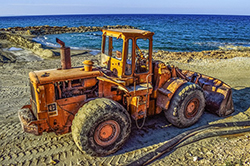 Bulldozers, scrapers, and tractors, oh my! A jobsite crawling with heavy equipment can sometimes feel like a danger zone. However, with the proper heavy equipment safety guidelines in place, you can reduce risk on your jobsite and ensure your workers head home unscathed each and every day.
Bulldozers, scrapers, and tractors, oh my! A jobsite crawling with heavy equipment can sometimes feel like a danger zone. However, with the proper heavy equipment safety guidelines in place, you can reduce risk on your jobsite and ensure your workers head home unscathed each and every day.
There are three main ingredients to safe heavy equipment operation: Safe equipment, proper training and a safe attitude, and constant awareness of all jobsite activities. If heavy equipment operators are armed with these three tools, they’ll have no problem playing it safe. Read on to learn more about these and other essential safety factors for operating heavy equipment on the jobsite.
Play it safe with dependable equipment
The Occupational Safety & Health Administration (OSHA) puts a lot of emphasis on the safety features of heavy equipment. However, there’s much more to keeping equipment safe than just inspecting the machine’s safety features. After all, countless things can go wrong with this complex equipment, and these problems can lead to some major risks on the jobsite.
Therefore, it’s extremely important to create customized inspection checklists for each unique piece of equipment. Safety experts recommend that heavy equipment operators conduct a pre-operational walk around and pre-start up (in cab) inspection each and every day before they crank up.
During this inspection, the worker should ensure that service, emergency, and parking brakes are all functioning; headlights, taillights, and backup lights are operating properly; and that the horn is working. Of course, these are just a few of the items that should be included on the checklist. Employers should create customized checklists for each piece of equipment based on both OSHA guidelines and the information provided in the equipment operating manual.
Steer clear of jobsite dangers
Heavy equipment operators should be well aware of all jobsite activities so they can avoid any potential dangers. That’s why it’s critical for equipment operators to walk through site activity checklists daily. Here are a few obstacles and activities operators should stay on the lookout for:
Overhead lines: Many fatal occupational injuries occur each year in the U.S. due to contact between large jobsite equipment and overhead lines. That’s why equipment operators must exercise extreme caution when working anywhere near overhead power lines. Workers should assume that all overhead lines are energized, unless electrical utility authorities have indicated otherwise, and that they’re grounded visibly and marked appropriately. OSHA provides specific requirements for the safe use of equipment near overhead lines.
Barricades: Barricades must be used on any jobsite where heavy equipment is in operation. These barricades help to notify workers where equipment is in use so that they can stay out of the area and avoid serious injury.
Hand Signals: If a crane is operating on a jobsite, the crane operator and the signaler must know the hand signals that are required by OSHA. These hand signals can be used for other types of equipment, as well.
Ensure safety with well-trained workers
Of course, a jobsite is only as safe as its workers. That’s why it’s so important to employ only well-trained, safety-conscious workers for a heavy equipment jobsite. According to OSHA requirements, jobsites, materials, and equipment should undergo frequent and regular inspections only by “competent persons” designated by the employer. It takes training to be a competent worker.
It’s extremely important to train your employees on proper equipment inspection and operation safety. After all, your workers’ lives could depend on it. For more information, visit the OSHA website at www.osha.gov.





